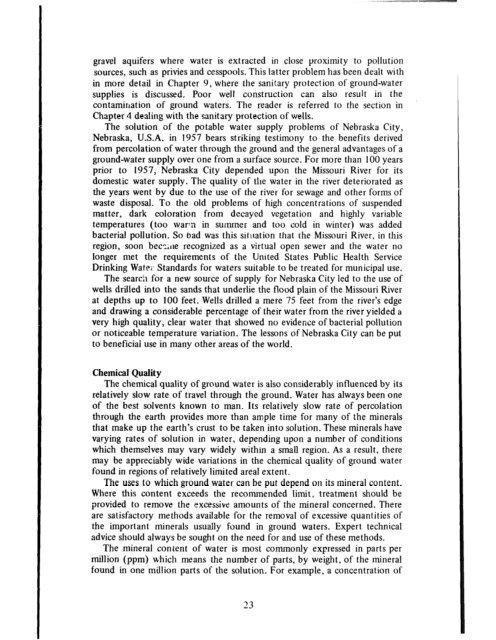Water Well Manual (USAID).pdf - The Water, Sanitation and Hygiene
Water Well Manual (USAID).pdf - The Water, Sanitation and Hygiene
Water Well Manual (USAID).pdf - The Water, Sanitation and Hygiene
You also want an ePaper? Increase the reach of your titles
YUMPU automatically turns print PDFs into web optimized ePapers that Google loves.
gravel aquifers where water is extracted in close proximity to pollution<br />
sources, such as privies <strong>and</strong> cesspools. This latter problem has been dealt with<br />
in more detail in Chapter 9, where the sanitary protection of ground-water<br />
supplies is discussed. Poor well construction can also result in the<br />
contamination of ground waters. <strong>The</strong> reader is referred to the section in<br />
Chapter 4 dealing with the sanitary protection of wells.<br />
<strong>The</strong> solution of the potable water supply problems of Nebraska City,<br />
Nebraska, U.S.A. in 1957 bears striking testimony to the benefits derived<br />
from percolation of water through the ground <strong>and</strong> the general advantages of’a<br />
ground-water supply over one from a surface source. For more than 100 years<br />
prior to 1957, Nebraska City depended upon the Missouri River for its<br />
domestic water supply. <strong>The</strong> quality of the water in the river deteriorated as<br />
the years went by due to the use of the river for sewage <strong>and</strong> other forms of<br />
waste disposal. To the old problems of high concentrations of suspended<br />
matter, dark coloration from decayed vegetation <strong>and</strong> highly variable<br />
temperatures (too warn in summer <strong>and</strong> too cold in winter) was added<br />
bacterial pollution. So bad was this sittration that the Missouri River, in this<br />
region, soon beczrre recognized as a virtual open sewer <strong>and</strong> the water no<br />
longer met the requirements of the United States Public Health Service<br />
Drinking Watei- St<strong>and</strong>ards for waters suitable to be treated for municipal use.<br />
<strong>The</strong> search for a new source of supply for Nebraska City led to the use of<br />
wells drilled into the s<strong>and</strong>s that underlie the flood plain of the Missouri River<br />
at depths up to 100 feet. <strong>Well</strong>s drilled a mere 75 feet from the river’s edge<br />
<strong>and</strong> drawing a considerable percentage of their water from the river yielded a<br />
very high quality, clear water that showed no evidence of bacterial pollution<br />
or noticeable temperature variation. <strong>The</strong> lessons of Nebraska City can be put<br />
to beneficiai use in many other areas of the world.<br />
Chemical Quality<br />
<strong>The</strong> chemical quality of ground water is also considerably influenced by its<br />
relatively slow rate of travel through the ground. <strong>Water</strong> has always been one<br />
of the best solvents known to man. Its relatively slow rate of percolation<br />
through the earth provides more than am

















